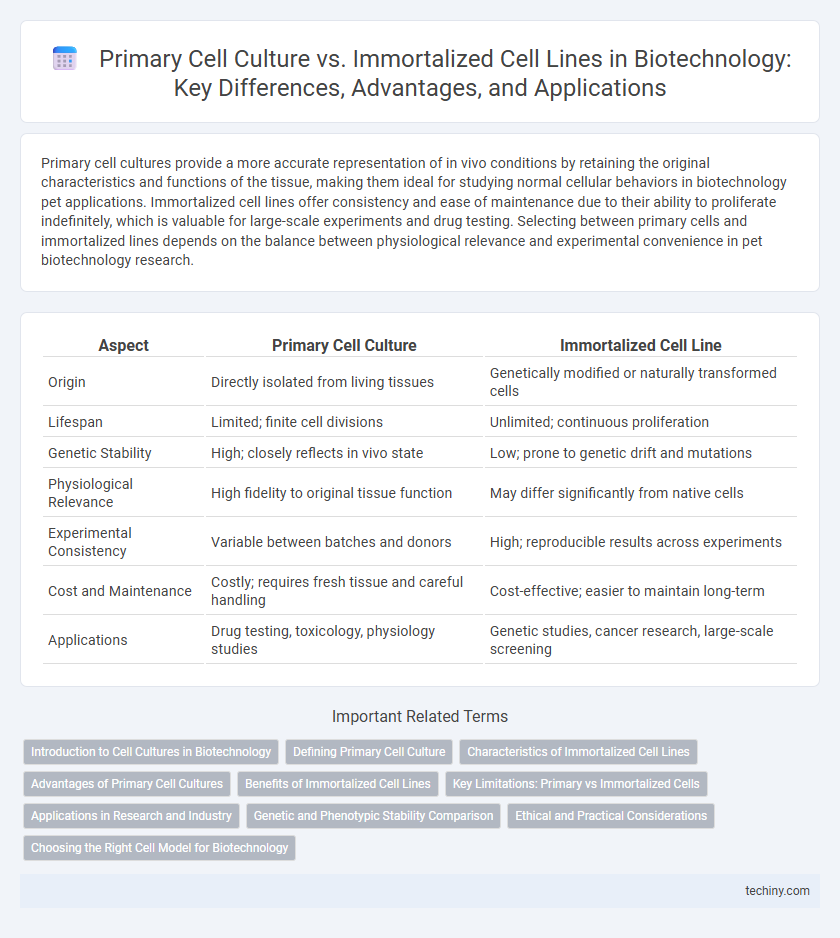Primary cell cultures provide a more accurate representation of in vivo conditions by retaining the original characteristics and functions of the tissue, making them ideal for studying normal cellular behaviors in biotechnology pet applications. Immortalized cell lines offer consistency and ease of maintenance due to their ability to proliferate indefinitely, which is valuable for large-scale experiments and drug testing. Selecting between primary cells and immortalized lines depends on the balance between physiological relevance and experimental convenience in pet biotechnology research.
Table of Comparison
| Aspect | Primary Cell Culture | Immortalized Cell Line |
|---|---|---|
| Origin | Directly isolated from living tissues | Genetically modified or naturally transformed cells |
| Lifespan | Limited; finite cell divisions | Unlimited; continuous proliferation |
| Genetic Stability | High; closely reflects in vivo state | Low; prone to genetic drift and mutations |
| Physiological Relevance | High fidelity to original tissue function | May differ significantly from native cells |
| Experimental Consistency | Variable between batches and donors | High; reproducible results across experiments |
| Cost and Maintenance | Costly; requires fresh tissue and careful handling | Cost-effective; easier to maintain long-term |
| Applications | Drug testing, toxicology, physiology studies | Genetic studies, cancer research, large-scale screening |
Introduction to Cell Cultures in Biotechnology
Primary cell cultures consist of cells directly isolated from living tissues, maintaining physiological relevance and heterogeneity essential for accurate biological studies. Immortalized cell lines are genetically modified or naturally transformed cells capable of indefinite proliferation, providing a consistent and convenient model for experimental reproducibility. Both cell culture types are fundamental in biotechnology for drug development, toxicity testing, and understanding cellular mechanisms.
Defining Primary Cell Culture
Primary cell culture involves isolating cells directly from living tissues, preserving their natural physiological characteristics and genetic makeup. These cultures exhibit limited lifespan and growth potential, reflecting in vivo conditions more accurately than immortalized cell lines. They serve as essential models for studying cell behavior, drug responses, and disease mechanisms in biotechnology research.
Characteristics of Immortalized Cell Lines
Immortalized cell lines possess the key characteristic of continuous proliferation due to genetic modifications that bypass cellular senescence, enabling indefinite growth under appropriate conditions. These cell lines often exhibit altered gene expression profiles and may show reduced differentiation potential compared to primary cell cultures. Their robustness, reproducibility, and ease of maintenance make them essential tools for high-throughput screening, drug development, and molecular biology research.
Advantages of Primary Cell Cultures
Primary cell cultures preserve the physiological relevance and genetic stability of original tissues, providing more accurate models for studying cellular functions and drug responses. They exhibit natural cellular heterogeneity and maintain in vivo-like morphology, supporting more predictive experimental outcomes. These cultures reduce artifacts caused by genetic mutations commonly found in immortalized cell lines, enhancing translational research reliability.
Benefits of Immortalized Cell Lines
Immortalized cell lines offer consistent and reproducible results due to their ability to proliferate indefinitely, eliminating variability present in primary cell cultures. These cell lines provide a scalable platform for high-throughput drug screening and genetic manipulation, essential for advanced biotechnological research. Their robustness and ease of maintenance reduce experimental costs and accelerate timelines in pharmaceutical development and cellular studies.
Key Limitations: Primary vs Immortalized Cells
Primary cell cultures exhibit limited lifespan and undergo senescence, restricting long-term experiments and large-scale production. In contrast, immortalized cell lines possess indefinite proliferation capabilities but often display genetic drift and altered phenotypes, impacting experimental relevance. These limitations necessitate careful selection based on study objectives, balancing physiological accuracy against reproducibility and scalability.
Applications in Research and Industry
Primary cell culture provides biologically relevant models closely resembling in vivo conditions, critical for drug testing, toxicology studies, and disease modeling. Immortalized cell lines offer consistent, reproducible growth and cost-effective large-scale production, essential in high-throughput screening, genetic research, and biopharmaceutical manufacturing. Combining both systems enhances translational research and accelerates biotechnological innovation across academia and industry.
Genetic and Phenotypic Stability Comparison
Primary cell cultures exhibit higher genetic and phenotypic stability as they closely mimic in vivo conditions, maintaining normal cell morphology and function over limited passages. Immortalized cell lines, while capable of indefinite proliferation, often acquire genetic mutations and phenotypic drift due to extended culture and artificial immortalization processes. These alterations can impact experimental reproducibility and relevance in biotechnology research applications.
Ethical and Practical Considerations
Primary cell culture offers ethical advantages by closely representing in vivo conditions without genetic modifications, reducing concerns related to altered cell behavior. Immortalized cell lines provide practical benefits, including indefinite proliferation and ease of maintenance, yet raise ethical questions regarding genetic manipulation and potential misrepresentation of physiological responses. Balancing the authenticity of primary cells with the convenience of immortalized lines is crucial in biotechnological research design.
Choosing the Right Cell Model for Biotechnology
Primary cell cultures retain the physiological characteristics and genetic stability of their tissue of origin, making them ideal for studying normal cellular functions and drug responses in biotechnology research. Immortalized cell lines offer extended lifespan and ease of genetic manipulation, providing consistent and reproducible results for large-scale production and high-throughput screening. Selecting the appropriate cell model depends on experimental goals, with primary cells preferred for relevance and immortalized cells favored for scalability and durability.
Primary cell culture vs Immortalized cell line Infographic

 techiny.com
techiny.com